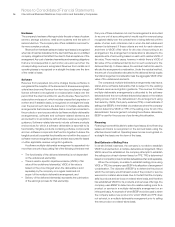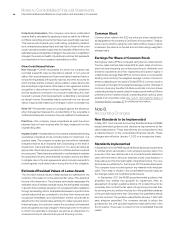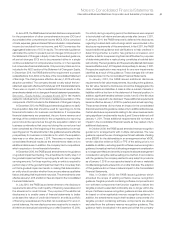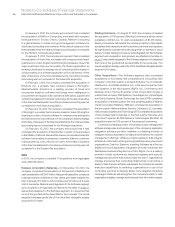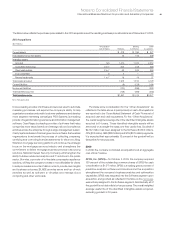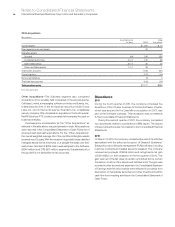IBM 2011 Annual Report Download - page 87
Download and view the complete annual report
Please find page 87 of the 2011 IBM annual report below. You can navigate through the pages in the report by either clicking on the pages listed below, or by using the keyword search tool below to find specific information within the annual report.
Notes to Consolidated Financial Statements
International Business Machines Corporation and Subsidiary Companies 85
Cash Equivalents
All highly liquid investments with maturities of three months or less at
the date of purchase are considered to be cash equivalents.
Marketable Securities
Debt securities included in current assets represent securities that
are expected to be realized in cash within one year of the balance
sheet date. Long-term debt securities that are not expected to be
realized in cash within one year and alliance equity securities are
included in investments and sundry assets. Debt and marketable
equity securities are considered available for sale and are reported
at fair value with unrealized gains and losses, net of applicable taxes,
recorded in other comprehensive income/(loss). The realized gains
and losses for available-for-sale securities are included in other
(income) and expense in the Consolidated Statement of Earnings.
Realized gains and losses are calculated based on the specific
identification method.
In determining whether an other-than-temporary decline in market
value has occurred, the company considers the duration that, and
extent to which, the fair value of the investment is below its cost, the
financial condition and near-term prospects of the issuer or underlying
collateral of a security; and the company’s intent and ability to retain
the security in order to allow for an anticipated recovery in fair value.
Other-than-temporary declines in fair value from amortized cost for
available-for-sale equity and debt securities that the company intends
to sell or would more-likely-than-not be required to sell before the
expected recovery of the amortized cost basis are charged to other
(income) and expense in the period in which the loss occurs. For
debt securities that the company has no intent to sell and believes
that it more-likely-than-not will not be required to sell prior to recovery,
only the credit loss component of the impairment is recognized in
other (income) and expense, while the remaining loss is recognized
in other comprehensive income/(loss). The credit loss component
recognized in other (income) and expense is identified as the amount
of the principal cash flows not expected to be received over the
remaining term of the debt security as projected using the company’s
cash flow projections.
Inventories
Raw materials, work in process and finished goods are stated at the
lower of average cost or market. Cash flows related to the sale of
inventories are reflected in net cash from operating activities in the
Consolidated Statement of Cash Flows.
Allowance for Credit Losses
Receivables are recorded concurrent with billing and shipment of a
product and/or delivery of a service to customers. A reasonable
estimate of probable net losses on the value of customer receivables
is recognized by establishing an allowance for credit losses.
Notes and Accounts Receivable—Trade
An allowance for uncollectible trade receivables is estimated based
on a combination of write-off history, aging analysis and any specific,
known troubled accounts.
Financing Receivables
Financing receivables include sales-type leases, direct financing
leases and loans. Leases are accounted for in accordance with lease
accounting standards. Loan receivables are financial assets recorded
at amortized cost which approximates fair value. The company
determines its allowances for credit losses on financing receivables
based on two portfolio segments: lease receivables and loan
receivables (see note F, “Financing Receivables,” on pages 101 to
104). The company further segments the portfolio via two classes:
major markets and growth markets.
When calculating the allowances, the company considers its
ability to mitigate a potential loss by repossessing leased equipment
and by considering the current fair market value of any other collateral.
The value of the equipment is the net realizable value. The allowance
for credit losses for capital leases, installment sales and customer
loans includes an assessment of the entire balance of the capital
lease or loan, including amounts not yet due. The methodologies that
the company uses to calculate its receivables reserves, which are
applied consistently to its different portfolios, are as follows:
Individually Evaluated—The company reviews all financing
receivables considered at risk on a quarterly basis. The review primarily
consists of an analysis based upon current information available
about the customer, such as financial statements, news reports,
published credit ratings, current market-implied credit analysis, as
well as the current economic environment, collateral net of
repossession cost and prior collection history. For loans that are
collateral dependent, impairment is measured using the fair value of
the collateral when foreclosure is probable. Using this information, the
company determines the expected cash flow for the receivable and
calculates an estimate of the potential loss and the probability of loss.
For those accounts in which the loss is probable, the company
records a specific reserve.





